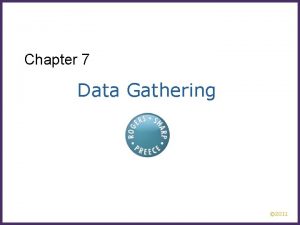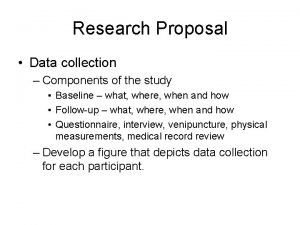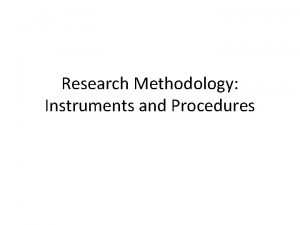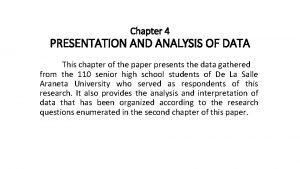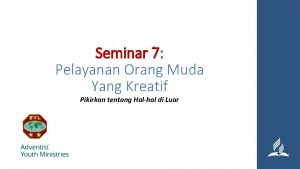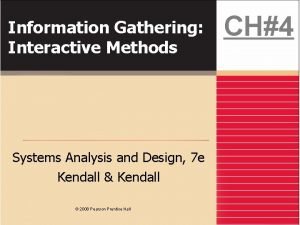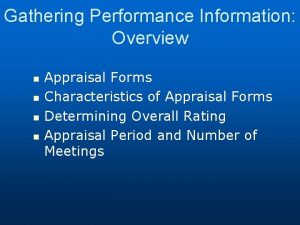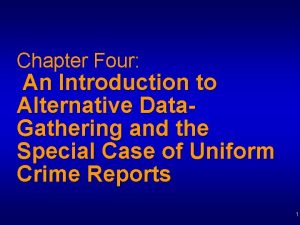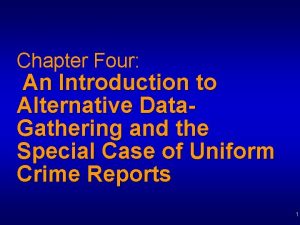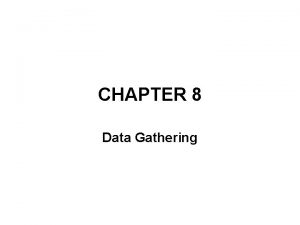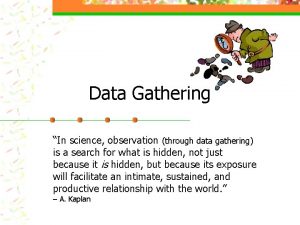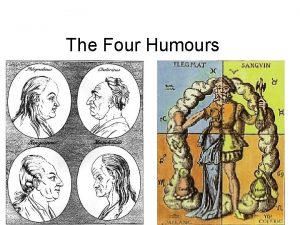Chapter Four An Introduction to Alternative Data Gathering




























- Slides: 28

Chapter Four: An Introduction to Alternative Data. Gathering and the Special Case of Uniform Crime Reports 1

Alternative Data-Gathering Strategies u The experiment as a method of data gathering is by no means the best strategy, despite its obvious strengths. u No all topics lend themselves to experiments. Experiments have weaknesses that other data gathering strategies do not have. u 2

Alternative Data-Gathering Strategies u u There are other types of data gathering strategies which have better external validity and are NOT characterized by their artificiality. Examples of alternative data-gathering strategies: social surveys, participant observation, case studies, unobtrusive measures. 3

Social surveys u u u A means of data gathering in which a segment of the population reports their attitudes and/or behavior. IE: (questionnaires, interviews, telephone contact) Can be powerful tools for obtaining quantitative data for statistical analysis; Statistics can control for RCF’s 4

Participant Observation u Occurs when a researcher observes a group by participating, to varying degrees, in the activities of the group. u Favorite tool of anthropologists. u For some subjects participant observation may be the only visible data-gathering strategy. 5

Case Studies u u Case studies - In-depth analysis of one or a few cases. Represent a commitment to a qualitative or sensitizing strategy. Provide a micro-criminological or in-depth close-up of only a few subjects IE: Edwin Sutherland’s The Professional Thief (1937), Clifford Shaw’s “Brothers in Crime” 6

Life Histories u Generally involve the analysis of diaries, letters, biographies, and autobiographies. u IE: Clifford Shaw’s “The Jack-roller” (1930) u Oral histories are “recounts of events by participants. ” 7

Unobtrusive Measures u u Non-reactive methods of data gathering. Any methods of gathering data in which the subjects are NOT aware of being analyzed. IE: Analysis of existing data, UCR data, trace analysis Usually an inexpensive alternative to data gathering. 8

The Special Case of Uniform Crime Reports u Traditionally the most widely used measure of crime in the United States. u Began in 1930 by U. S. Department of Justice. u Compilation of national crime statistics. Law enforcement agencies send statistics to DOJ. 9

The Special Case of Uniform Crime Reports u The UCR comprises crimes known to, and recorded by, local police departments. u These statistics do not take into account the “dark figure of crime. ” In the 1980’s about 98% of metropolitan police agencies reported its crimes to the FBI. u 10

The Crime Index u The UCR is divided into Part 1 and Part 2 crimes. u Part 1 consists of index crimes which are MAJOR felonies reported to the police: Murder and non-negligent manslaughter, forcible rape, robbery, aggravated assault, burglary, larceny-theft, motor vehicle theft, arson u 11

The Crime Index u u u Part 2 crimes are non-index crimes: Includes minor offenses, such as, simple assault, vandalism, gambling, and drunkenness The FBI can not vouch for the validity of reports, but it examines them for accuracy, eliminates and makes special inquiries for crass errors 12

Crime Rate u u u The crime rate is expressed as the number of crimes per unit of population size. Permits a fair comparison of different size units. Crime rate = # of index crimes X 100. 000 Population 13

Calculating the Crime Rate u This is very important. Newspapers are sold and jobs are won and lost depending on what the crime rate is. u Question: If the City of Houston has a population of 4, 900, 000 with 506 homicides a year. How would you calculate the homicide rate? 14

Limitations of UCR Data u Recorded statistics represent only a portion of the true crime rate. (Probably 2 x as much). u Citizens’ tendency to report crime may change because of a general change in public morality (barroom brawls) 15

Limitations of UCR Data u Most victimless crimes and white collar crimes are not contained in the UCR u Changes in a police department’s statistical tabulating process may affect how the crime rate is recorded. u Political pressure to lie. 16

Limitations of UCR Data u Hierarchy rule - Only the most serious crime is reported in any single incident. u The crime index is an un-weighted index - all crimes count the same; IE: A murder counts the same as a bicycle theft. 17

Limitations of UCR Data u Crime index may cause police agencies to concentrate on these crimes at the expense of other crimes. u Larceny and arson should not be included as an index crime. u In cases of arson it can be hard to tell whether or not intentional. 18

Crime dip u Stabilization or decline in crime. u Demographic shifts may provide some explanation for rapidly rising or falling crime rates. u Criminologists using UCR data were able to forecast the crime dip in the 1980’s. 19

UCR Redesign u Beginning in 1977, the International Association of Chiefs of Police and the National Sheriffs Association called for a major redesign of the UCR system u Today the National Incident-Based Reporting System (NIBRS) is replacing the UCR. 20

National Incident-Based Reporting System u u u NIBRS uses fifty-two data elements to describe: victims, offenders, and circumstances of crimes. 1 st overhaul of UCR in 50 yrs NIBRS includes many different types of crimes, such as, bribery, pornography, fraud, and non-forcible sex offenses. 21

National Incident-Based Reporting System u NIBRS will eventually replace the UCR as the official source of crimes reported to law enforcement agencies. u Represents a new way of thinking about crime. Illustrates close partnership among BJS, FBI, and over 17, 000 law enforcement agencies u 22

NIBRS versus UCR u 1. ) Incident-Based v. Summary Reporting: NIBRS reports include fifty-two data elements describing victims, offenders, and circumstances of the crime. u 2. ) NIBRS includes more possible types of crimes: UCR has 8 Part I Crimes, NIBRS has 46 Group A 23

NIBRS versus UCR u 3. ) NIBRS, unlike UCR, makes a distinction between attempted and completed crimes. u 4. ) Elimination of the “hierarchy rule” (under UCR). Cites all offenses within the same incident. 5. ) Designation of “Computer Crimes” u 24

NIBRS versus UCR u 6. ) Better statistical analysis: Greater opportunities for examining interrelationships between many variables such as offenses, property, victims, offenders, and arrestees. u 7. ) NIBRS includes “Crimes Against Society” - ie: prostitution, drug offenses, gambling, pornography. 25

NIBRS versus UCR u 8. ) Greater specificity of data: Because NIBRS collects more specific information, which can lead to better criminal profiling. IE: NIBRS tells a researcher whether or not drugs/alcohol were involved; injuries sustained; types of weapons; relationship between victim and offender; location. A plethora of information. 26

Interpol, United Nations, World Health Organizations u The above organizations represent an international effort with respect to crime statistics. u IE: Interpol puts out its crime statistics. This type of data may give insight into crimes in other countries and provide a basis for comparison. u 27

Interpol, United Nations, World Health Organizations u CAUTION: Some of the same problems in analyzing international data are the same as those affecting the UCR. u Problems: Varying definitions of crime across countries, differences in law, differences in recording practices, different urban/rural, economic structures, political factors 28
 Data gathering for quantitative research
Data gathering for quantitative research Data gathering procedures example
Data gathering procedures example Apa itu data requirement gathering
Apa itu data requirement gathering Data warehouse requirements gathering
Data warehouse requirements gathering Data gathering procedure
Data gathering procedure Five key issues of data gathering
Five key issues of data gathering Five key issues of data gathering
Five key issues of data gathering Research proposal data collection
Research proposal data collection Example of research instrument
Example of research instrument Nat 5 pe
Nat 5 pe 6.02 gathering weather data
6.02 gathering weather data Instrument for research data collection
Instrument for research data collection Example of data gathering procedure
Example of data gathering procedure Methods of gathering data higher pe
Methods of gathering data higher pe What is the setting of gathering blue
What is the setting of gathering blue Classification alternative techniques in data mining
Classification alternative techniques in data mining Data presentation and analysis
Data presentation and analysis Chapter 32 complementary and alternative therapies
Chapter 32 complementary and alternative therapies Chapter 11 complementary and alternative medicine
Chapter 11 complementary and alternative medicine Shapes with straight sides
Shapes with straight sides Skin assessment charting
Skin assessment charting Introduction to data warehouse
Introduction to data warehouse Ux requirements gathering
Ux requirements gathering Youth ministry topics
Youth ministry topics Types of news gathering
Types of news gathering What is information gathering in system analysis and design
What is information gathering in system analysis and design Types of deflation
Types of deflation Fact finding questions
Fact finding questions Electronic newsgathering
Electronic newsgathering






